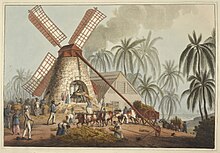**Historical Development of Sugar Plantations in the Caribbean**:
– Introduction of sugar plantations in the Americas by Portuguese and Spanish in the 1550s.
– Transition of sugar cultivation from South America to the Caribbean due to factors like Dutch influence and technological advancements.
– Establishment of Barbados as the sugar and rum capital of the Caribbean.
– Dominance of Jamaica, Saint Domingue, and later Cuba in sugar production.
– Economic impact on colonies like Haiti and Puerto Rico, and the use of diverse labor sources post-slavery.
**Social and Economic Impact of Sugar Culture**:
– Increase in the ratio of slaves to free men on sugar plantations.
– Growth in plantation size with the use of African slaves.
– Formation of trade interests like the West India Interest for sugar trading.
– Role of sugar plantations in shaping demographics and wealth distribution in the Caribbean.
– Legislative impacts like the Slave Trade Act of 1807 and the Emancipation Bill of 1833 on slavery.
**Environmental Impact of Sugar Plantations**:
– Deforestation, water pollution, and soil erosion caused by the sugar cane industry.
– Ecological losses in various Caribbean countries due to monoculture for sugar plantations.
– Measures taken to mitigate the environmental impacts of the sugar revolution, including irrigation and addressing water pollution.
**Slavery on Caribbean Sugar Plantations**:
– Forced labor of indigenous peoples and the introduction of African slaves due to the decimation of indigenous populations.
– Labor-intensive nature of sugarcane harvesting and the technical skills required.
– Tasks performed by enslaved individuals until emancipation.
– Impact of legislative acts like the Slave Trade Act of 1807 and the Emancipation Bill of 1833 on slavery in the Caribbean.
**Gender Dynamics and Social Realities on Sugar Plantations**:
– Integral roles played by women in social dynamics and labor on plantations.
– Majority of field slaves being women, working in the fields while bearing children.
– Evidence of brutality towards enslaved women and prevalence of interpersonal abuse and domestic violence.
– Gendering of health, wealth, and energy on sugar plantations and the archaeological findings supporting these dynamics.
Sugar plantations in the Caribbean were a major part of the economy of the islands in the 18th, 19th, and 20th centuries. Most Caribbean islands were covered with sugar cane fields and mills for refining the crop. The main source of labor, until the abolition of chattel slavery, was enslaved Africans. After the abolition of slavery, indentured laborers from India, China, Portugal and other places were brought to the Caribbean to work in the sugar industry. These plantations produced 80 to 90 percent of the sugar consumed in Western Europe, later supplanted by European-grown sugar beet.



